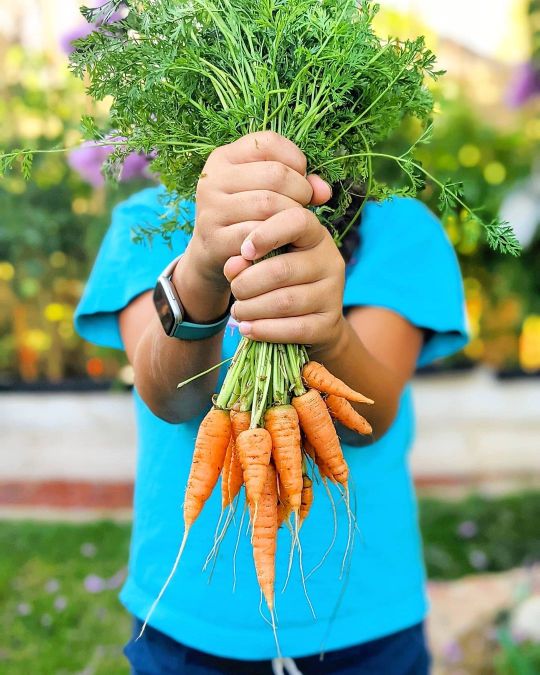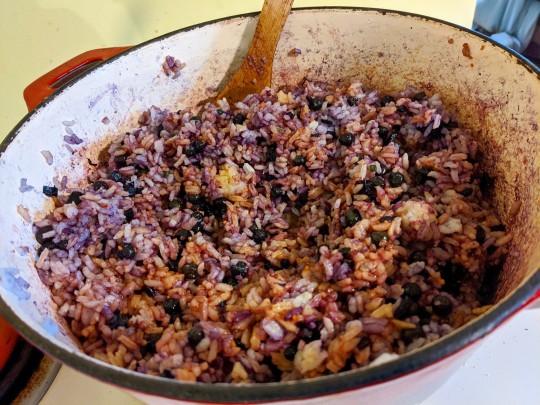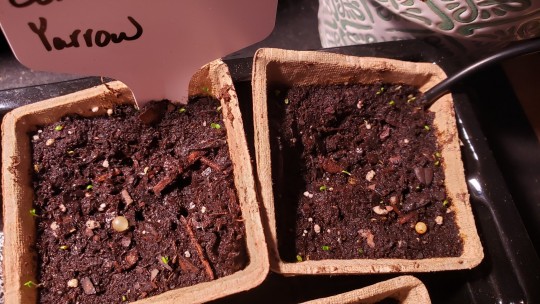#pusa asita
Photo

Pusa Asita Black Carrot seedlings.
3 notes
·
View notes
Text
Got my catnip planted and ordered some heirloom seeds & carrot seeds! I've got pusa asitas, longue rouge sangs, little fingers, and baby milk bok choy on the way. The place I buy from also does free seed packs, and I'm super excited to see what's in mine! I think I'm gonna start with the little fingers this year, and expand my carrot garden next year after I get some more space on my patio.
42 notes
·
View notes
Text
I went to Lowe's and bought 4 big seed trays and now I think I may need more hahaha! I have these 8 hanging pots off my fence in the backyard so I started some Chiltepin peppers. Those are separate from my beds as they'll end up in the pots. But today, I planted my black/purple Pusa Asita carrots and Big Jim peppers

#garden#backyard#gardening#outdoor gardening#plants#growing season#peppers#raised bed gardening#container gardening#carrots
1 note
·
View note
Photo

👩🏾🌾The kids harvested their 🥕 Pusa Asita Black, Longue Rouge Sang, Rainbow Mix, Danvers and Kaleidoscope Mix My favorite is the sweet Danvers but that Pusa Asita Carrot is the darkest I've ever seen! It's beautiful!! Also I need a new hand model that listens, Hailey is crazy! 😂 . . . #harvest #carrot #carrots #mygarden #summer #july #plantlover #plantaddict #vegetables #fruit #instagarden #plants #gardeninspo #garden #gardeninspiration #gardens #gardenlife #islandgirl #SoCal #california #teampixel #losangeles #zone9garden #zone9b #9b #urbangarden (at California) https://www.instagram.com/p/CR9Ue1oFUlO/?utm_medium=tumblr
#harvest#carrot#carrots#mygarden#summer#july#plantlover#plantaddict#vegetables#fruit#instagarden#plants#gardeninspo#garden#gardeninspiration#gardens#gardenlife#islandgirl#socal#california#teampixel#losangeles#zone9garden#zone9b#9b#urbangarden
2 notes
·
View notes
Text

When you use pusa asita black carrots, you end up with purple chicken fried rice 😂
#friedrice#chickenfriedrice#carrot#pusaasita#blackcarrots#purple#purplecarrot#homegrown#homecooking#bakercreekheirloomseeds#bakercreekseeds
1 note
·
View note
Text
A Guide to Different Colored Carrots
A large culinary family includes cumin, dill, fennel, parsnips, parsley, cilantro and different colored carrots. Though carrots are primarily eaten for the roots, it wasn’t always this way. Carrots also weren’t always orange.
Back to Our Roots
As early as 3,000 BC, German inhabitants started growing carrots for their highly fragrant leaves and seeds, since the roots were narrow and woody. They emerged in Afghanistan as the modern root we eat today, though they were different colored. Carrots from West Asia, India and Europe were purple. An 11th century Jewish scholar described red and yellow roots, a claim upheld by 12th century Arab-Andalusian agriculturist Ibn al’-Awwam. Descendants of these eastern carrot varieties are usually purple or yellow and have branched roots instead of a thick, long column.
The structure of the carrot changed in the Netherlands in the 17th century. Several popular tales exist to explain the sudden emergence of orange from different colored carrots. One says it developed as an emblem of the House of Orange and the Dutch struggle for independence. Others claim it honored William, who lead a victorious revolt against Spain in 1544. William’s seat was in a place pronounced “Aurenja,” in France, and the name was later confused with the French word for “orange.” Western cultivars are classified by the root’s shape instead of his color. “Scarlet Nantes” identifies a cylindrical and blunt variety with a deep, reddish orange hue.
Dreaming of a Beautiful, Productive Veggie Garden?
Gardening experts offer their secrets to growing healthy, productive, and sustainable vegetable gardens. Download the free guide today. YES! I want this Free Guide »
Modern gardeners want something different. Colored carrots may offer phytonutrients or a delightful hue for juicing. They look stunning sitting in a basket beside zucchini and eggplant. Gardeners rarely want woody, forked varieties so top seed companies offer brilliant new selections. These include Red Samurai, an open-pollinated carrot, or the yellow Jaune Obtuse de Doubs, an ancient fodder crop. Royal hues include the Purple 68 hybrid or Pusa Asita black carrot for people who want to save heirloom seeds. A new rainbow variety produces different colored carrots from a single strain of F1 hybrid.
Purple 69, Red Samurai, Scarlet Nantes, and Yellowbunch
3 Crazy Carrot Myths
Most of these myths are laughable, though it’s surprising how many believe them.
Eating carrots improves your vision. The mostly widely accepted fallacy, this myth began in World War II. Britain’s air ministry developed a new and secret system that pinpointed Nazi aircraft before they could reach the English Channel. But Britain didn’t want the Germans to find out about the new technology so they formulated a rumor, hoping it was plausible. They claimed certain pilots attained “Cat’s Eyes” due to eating a lot of carrots. The rumor was so persuasive that British citizens started consuming massive amounts of carrots so they could see in the dark. Seventy-five years later, the majority of our society still believes it. The myth does have a little credibility, though; beta carotene may reduce the risk of cataracts and macular degeneration but it does not improve overall eyesight.
Carrots contain seeds. Though this myth is rare, it makes its way through potential gardeners interested in saving their own seeds. Carrots must be allowed to go to seed, meaning the green top must develop a thick stem with a flower atop. If the flower matures then dries, seeds may be harvested. But no seeds reside within the roots.
You can plant and grow “baby carrots.” This childhood misconception extends into adulthood. Carrots do not originate in plastic bags and they are not all one size and shape. Nor are baby carrots miniature varieties. They are larger carrots which have been shaved down into something a customer is more likely to buy, increasing the price for the consumer. Shavings are often processed into carrot juice. Baby carrots are so sweet and tender because the larger root has been whittled down to the tender core, discarding or reprocessing the rest. Shaving down baby carrots allows producers to sell overgrown roots which would otherwise only be marketable as juicing carrots. This practice doesn’t happen with different colored carrots because of marketability, though uncut purple carrots are sold for juicing.
As Above, So Beneath
Whether growing orange or different colored carrots, cultivation is easy if the gardener remembers a few tips.
Root vegetables which thrive in cold weather require temperatures a little warmer to sprout. As with growing radishes, daytime temperatures between 55 and 85 are necessary for germination. Carrots will not sprout at 95 degrees. Cold and wet soil encourages rotting. Because of this, the right time to plant carrots is in the spring, after soil is workable and the days have warmed, or in early autumn.
Carrots prefer loose, well-drained soil that is free of rocks. Mixing a little clean wood ash into the dirt prior to planting increases potassium for sweeter roots, in addition to adding phosphorus and magnesium. Root vegetables prefer an unobstructed path downward; if they meet a pebble, they will fork.
Though carrots may be grown in containers, beginning gardeners often don’t give them enough depth. A carrot with a thick, six-inch root may also have four more inches of long, skinny root at the end. Once that skinny end reaches the bottom of a planter, the carrot stops growing downward, even if the edible part will only be a few inches long. To ensure planters have enough depth for the entire root, consider the tops. A carrot with a foot-tall top should be given twelve inches of root space.
To plant carrots, turn soil until it is loose, mixing in light fertilizer such as rabbit manure. Rake the surface smooth then trace a thin trench into the dirt with a pencil or fingertip. Carefully and thinly sprinkle carrot seed into the trench then push soil back over it, just barely covering the seeds. Water using a fine mist spray. Seedlings will emerge within two to three weeks and will look like a pair of long, green blades. True leaves come next, tiny and frilly then growing tall.
Carrots need three to six inches between each plant to allow for adequate growth. If the sides touch, carrots stop growing. When the seedlings are tiny, and if the soil is loose, they can be redistributed to an appropriate distance apart by scooping into the soil with a large spoon and carefully lifting both seedling and soil. Gently separate seedlings. Then use the spoon to pull soil back in the seedling’s new location. Insert the plant and allow soil to fall back. Water well to reset the dirt and avoid transplant shock.
When carrots are several inches tall, mulch with straw or grass clippings. Carrots enjoy hot tops and cool roots. Mulching also avoids weeds which may compete for root space. Keep soil moist but not wet as carrots continue to grow.
Carrots can be eaten at any time during the growth cycle. If they were planted too closely and compete for space, pull several out and enjoy a sweet springtime snack. Most carrots mature within 75 days. To harvest, reach down as far as you can. Grab the root, not the leaves, or the greenery may break off while leaving the carrot in the ground. If necessary, dig down with a shovel to loosen the soil. Shake or wash the dirt off. Carrot tops may be composted or fed to livestock.
Unlike store-bought carrots, homegrown roots rarely need peeling. Simply hold beneath running water and scrub with a vegetable brush. If carrots have been grown organically, only the dirt must be removed.
To save carrot seeds, sacrifice the most beautiful and successful roots for the sake of perpetuation. Allow these to remain in the ground through the fall and winter. The next year, the carrot will develop a flower. Allowing the flower to develop creates the seeds in addition to attracting parasitic wasps which battle destructive pests like squash bugs. Let the seed heads fully mature on the plant then carefully clip off. Make sure seeds are completely dry before strong them in a ventilated container such as a paper envelope. Keep seeds in a cool, dark location.
Different colored carrots include white, yellow, orange, red, magenta, purple, and combinations of different colors. Look for them online if only orange varieties are available locally. Growing colored carrots is a fun and satisfying experience.
Do you grow different colored carrots? If so what is your favorite variety? Let us know in the comments below.
A Guide to Different Colored Carrots was originally posted by All About Chickens
0 notes
Text
Common Yarrow has sprouted! More stuff will be going in tomorrow including more seed trays because I sorely underestimated how much I'll be planting haha! Tomorrow the Pusa Asita carrots and Big Jim peppers will be starting

#garden#backyard#gardening#outdoor gardening#plants#growing season#raised bed gardening#yarrow#seeds#seedlings
1 note
·
View note
